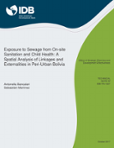Exposure to Sewage from On-site Sanitation and Child Health: A Spatial Analysis of Linkages and Externalities in Peri-Urban Bolivia
Date
Oct 2017
Exposure to fecal contamination is a leading cause of childhood infectious diseases inlow- and middle-income countries. Low-quality sanitation infrastructure and inadequate
maintenance can make on-site solutions such as latrines connected to septic tanks and
cesspools prone to spillage, exposing children to sewage. This paper uses a unique
dataset with independent verification of sewage in and around the land parcels of more
than 20,000 households with access to on-site sanitation in peri-urban Bolivia. The aim
is to analyze the relationship between exposure to sewage from overflowed sanitation
infrastructure and the incidence of diarrhea in children under age five. The presence of
sewage is associated with a 4 percentage point increase in the probability of diarrhea
incidence—a relative increase of 22 percent. That statistical relationship is driven by
sewage within the boundaries of the property where the child resides, which is
associated with a relative increase of 30 percent in the probability of the incidence of
diarrhea. Our spatial analysis of sewage density shows that the probability of the
incidence of diarrhea increases with the concentration of sewage in the immediate
vicinity of the child’s residence, suggesting negative spillovers from neighbors with
overflowed on-site sanitation facilities. The negative health externalities associated with
faulty on-site sanitation infrastructure provide a persuasive argument in favor of
government interventions that adequately remove and treat fecal sludge.
maintenance can make on-site solutions such as latrines connected to septic tanks and
cesspools prone to spillage, exposing children to sewage. This paper uses a unique
dataset with independent verification of sewage in and around the land parcels of more
than 20,000 households with access to on-site sanitation in peri-urban Bolivia. The aim
is to analyze the relationship between exposure to sewage from overflowed sanitation
infrastructure and the incidence of diarrhea in children under age five. The presence of
sewage is associated with a 4 percentage point increase in the probability of diarrhea
incidence—a relative increase of 22 percent. That statistical relationship is driven by
sewage within the boundaries of the property where the child resides, which is
associated with a relative increase of 30 percent in the probability of the incidence of
diarrhea. Our spatial analysis of sewage density shows that the probability of the
incidence of diarrhea increases with the concentration of sewage in the immediate
vicinity of the child’s residence, suggesting negative spillovers from neighbors with
overflowed on-site sanitation facilities. The negative health externalities associated with
faulty on-site sanitation infrastructure provide a persuasive argument in favor of
government interventions that adequately remove and treat fecal sludge.




